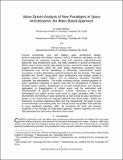| dc.contributor.author | Hastings, Daniel E. | |
| dc.contributor.author | La Tour, Paul Alexis | |
| dc.contributor.author | Putbrese, Benjamin | |
| dc.date.accessioned | 2015-01-30T18:30:50Z | |
| dc.date.available | 2015-01-30T18:30:50Z | |
| dc.date.issued | 2014-08 | |
| dc.identifier.isbn | 978-1-62410-257-8 | |
| dc.identifier.uri | http://hdl.handle.net/1721.1/93234 | |
| dc.description.abstract | Current commercial, civil, and military space architecture designs perform exquisitely and reliably. However, today’s architecture paradigms are also characterized by expensive launches, large and expensive high-performance spacecraft, long development cycles, and wide variations in ground architectures. While current assets provide high-quality services, and future assets are slated to improve performance within the same design frameworks, proposed future architectures may not be capitalizing on technology improvements, system innovations, or policy alternatives explored during the last two decades. This paper identifies five “trends” along which space architectures may develop, aimed at granting systems several “ilities,” such as resiliency, robustness, flexibility, scalability, and affordability. The trends examined include: commercialization of space, significant reductions in launch costs and the development of hybrid or reusable launch systems, development of on-orbit infrastructure and servicing, aggregation or disaggregation of orbital assets, and the automation and standardization of ground architectures. Further refinement of these key technological and system trends could result in major paradigm shifts in the development and fielding of space operations as well as lead to space architecture designs in the future that are radically different from those today. Within the framework of systems engineering ilities and risk management, this paper reviews current literature surrounding these new change trends and justifies their potential to cause significant paradigm shifts. By examining the work and research conducted so far through an ilities-based approach, systems engineers can more fully appreciate the value being offered by these trends. | en_US |
| dc.language.iso | en_US | |
| dc.publisher | American Institute of Aeronautics and Astronautics | en_US |
| dc.relation.isversionof | http://dx.doi.org/10.2514/6.2014-4444 | en_US |
| dc.rights | Creative Commons Attribution-Noncommercial-Share Alike | en_US |
| dc.rights.uri | http://creativecommons.org/licenses/by-nc-sa/4.0/ | en_US |
| dc.source | MIT web domain | en_US |
| dc.title | Value-Driven Analysis of New Paradigms in Space Architectures: An Ilities-Based Approach | en_US |
| dc.type | Article | en_US |
| dc.identifier.citation | La Tour, Paul, Benjamin L. Putbrese, and Daniel Hastings. “Value-Driven Analysis of New Paradigms in Space Architectures: An Ilities-Based Approach.” AIAA SPACE 2014 Conference and Exposition (August 2014). | en_US |
| dc.contributor.department | Massachusetts Institute of Technology. Department of Aeronautics and Astronautics | en_US |
| dc.contributor.department | Massachusetts Institute of Technology. Engineering Systems Division | en_US |
| dc.contributor.mitauthor | Hastings, Daniel E. | en_US |
| dc.contributor.mitauthor | La Tour, Paul Alexis | en_US |
| dc.contributor.mitauthor | Putbrese, Benjamin | en_US |
| dc.relation.journal | Proceedings of the AIAA SPACE 2014 Conference and Exposition | en_US |
| dc.eprint.version | Author's final manuscript | en_US |
| dc.type.uri | http://purl.org/eprint/type/ConferencePaper | en_US |
| eprint.status | http://purl.org/eprint/status/NonPeerReviewed | en_US |
| dspace.orderedauthors | La Tour, Paul; Putbrese, Benjamin L.; Hastings, Daniel | en_US |
| dc.identifier.orcid | https://orcid.org/0000-0001-6275-2513 | |
| dc.identifier.orcid | https://orcid.org/0000-0003-4421-5110 | |
| mit.license | OPEN_ACCESS_POLICY | en_US |
| mit.metadata.status | Complete | |
